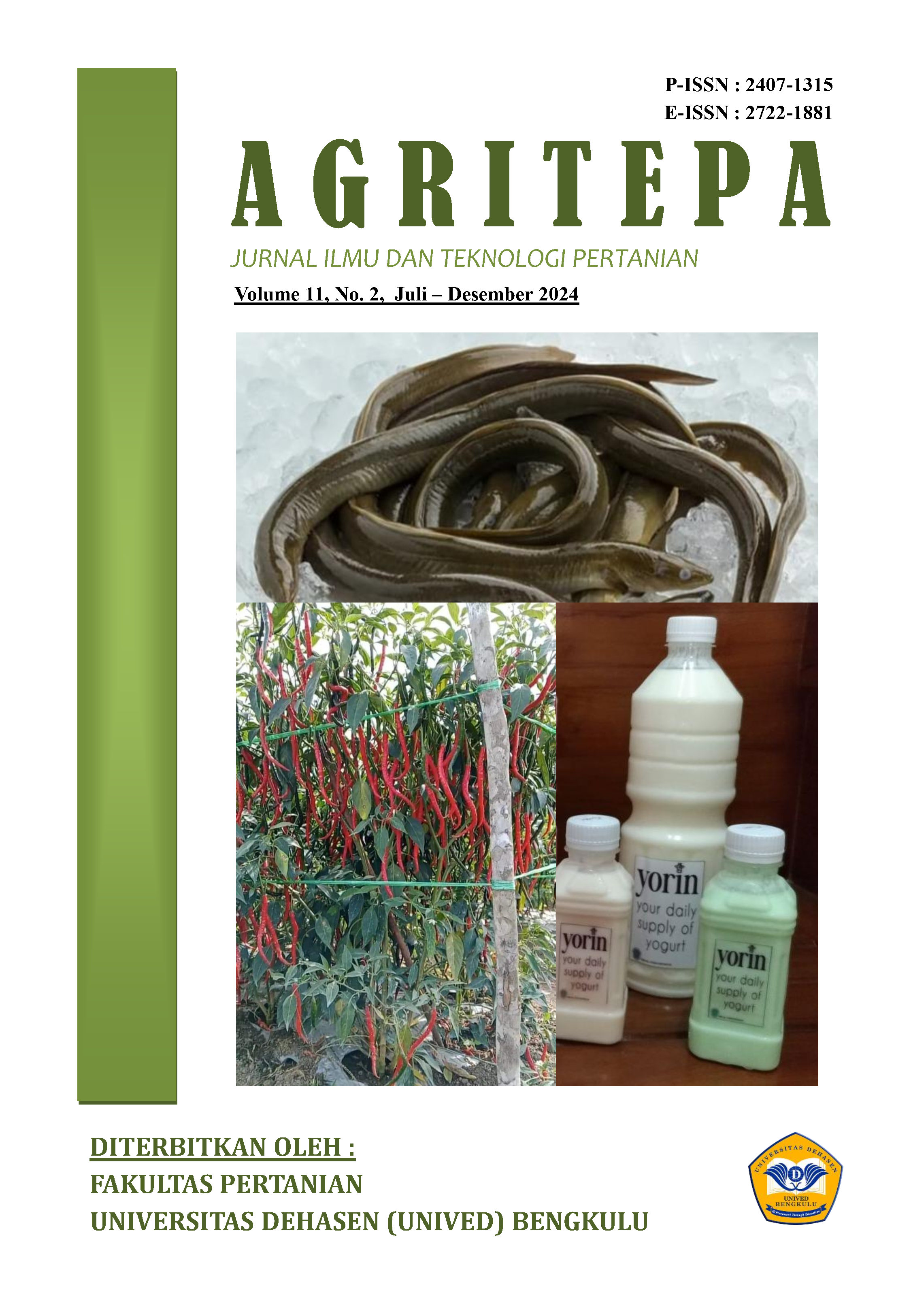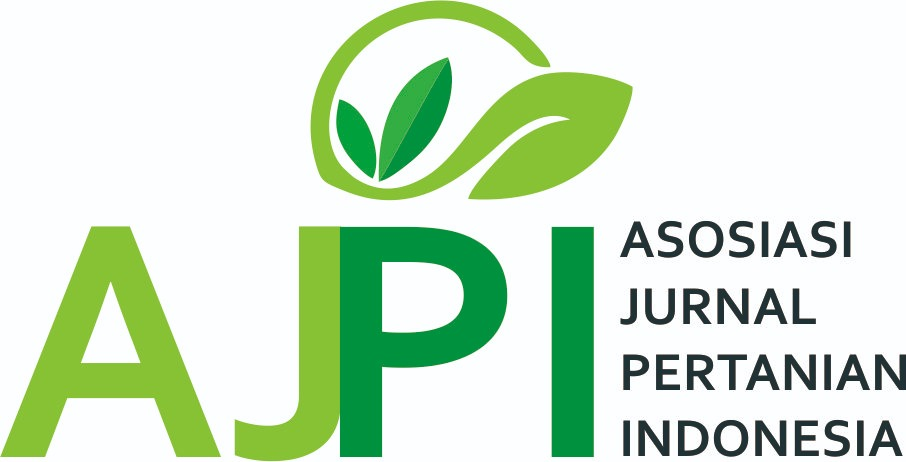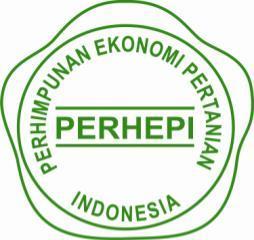Calorimetric Label Based On Teak And Ketapang Leaf Extracts As A Freshness Detector For Ground Beef
Abstract
Purpose: This research aims to prove the effectiveness of colorimetric labels based on teak leaf and ketapang leaf extracts as freshness detectors for ground beef. Methodology: The study was conducted through 3 stages, namely characterisation of natural extracts, manufacture of colorimetric labels and determination of the effectiveness of colour change of colorimetric labels. Characterisation of extracts through pH, TPT and RGB value test using image J software. The effectiveness of label colour change through colour test (L*, a*, and b*). The colour change was adjusted to the quality change of pH, total acid, and beef colour. Results: The pH, and colour values of teak leaves of 3.42; 81.17 were greater than ketapang leaves of 2.64 and 42.06. The TPT (̊ Brix) value of teak leaf extract (3.00) was lower than ketapang leaf extract (4.95). The results of colour parameter analysis L*, a*, and b* of teak and ketapang leaf colorimetric labels had no significant effect between 0, 3, and 6 hours. Ground beef experienced significantly different pH and total acid quality changes during storage with final values of 5.29 and 0.82%. Novelty: Research on the concept of colorimetric labels as freshness indicators based on pigments from teak leaves and ketapang leaves has not been widely studied, and this study shows the effectiveness of label colour changes with Whatman No. 1 paper carriers. Conclusion: The results showed that colorimetric labels based on old teak leaves and ketapang leaves were not effective in detecting the state of ground beef. Optimisation of the extraction method or the use of a different type of carrier is required. Paper Type: Research article
Downloads
References
Alfadila, R., Anandito, R.B.K. and Siswanti, S. (2020) ‘Pengaruh pemanis terhadap fisikokimia dan sensoris es krim sari kedelai jeruk manis (Citrus sinensis)’, Jurnal Teknologi Hasil Pertanian, 13(1), pp. 1–11.
Amalia, B. et al. (2021) ‘Karakterisasi label kolorimetrik dari karagenan/nanofiber selulosa dan ekstrak ubi ungu untuk indikator kerusakan pangan’, Jurnal Kimia dan Kemasan, 43(2), pp. 66–74.
Arfianty, B.N., Farisi, S. and Ekowati, C.N. (2017) ‘Dinamika Populasi Bakteri dan Total Asam Pada Fermentasi Bekasam Ikan Patin ( Pangasius hypopthalmus ) Bella Noor Arfianty , Salman Farisi , dan Christina Nugroho Ekowati’, Jurnal Biologi Eksperimen dan Keanekaragaman Hayati, 4(2), pp. 43–49. Available at: https://jurnalbiologi.fmipa.unila.ac.id/index.php/jbekh/article/download/133/118.
Badan Pusat Statistik (2024) Rata-Rata Konsumsi per Kapita Seminggu Beberapa Macam Bahan Makanan Penting, 2007-2023, Badan Pusat Statistik. Available at: https://www.bps.go.id/id/statistics-table/1/OTUwIzE=/rata-rata-konsumsi-per-kapita-seminggu-beberapa-macam-bahan-makanan-penting--2007-2023.html.
Buckle, K.A. et al. (2007) Ilmu Pangan. Jakarta: Universitas Indonesia (UI-Press).
Charoensit, P. et al. (2021) ‘Development of natural pigments from Tectona grandis (teak) leaves: Agricultural waste material from teak plantations’, Sustainable Chemistry and Pharmacy, 19, p. 100365. Available at: https://doi.org/https://doi.org/10.1016/j.scp.2020.100365.
Curll, J.B.T.-R.M. in F.S. (2016) ‘Food Regulations in Australia and New Zealand’, in. Elsevier. Available at: https://doi.org/https://doi.org/10.1016/B978-0-08-100596-5.03405-3.
Daud, A. and Sahriawati, S. (2018) ‘Pengembangan Prosedur Analisis Total Volatil Bases Dengan Menggunakan Indikator Alami’, Agrokompleks, 17(1), pp. 8–16.
Eriani, W. and Purnama, I.H. (2017) ‘Pengaruh Waktu Maserasi, Perlakuan Bahan Dan Zat Fiksasi Pada Pembuatan Warna Alami Daun Ketapang (Terminalia catappa Linn)’. Universitas Muhammadiyah Surakarta.
Ezati, P., Tajik, H. and Moradi, M. (2019) ‘Fabrication and characterization of alizarin colorimetric indicator based on cellulose-chitosan to monitor the freshness of minced beef’, Sensors and Actuators B: Chemical, 285, pp. 519–528.
Fakih Kurniawan, M. et al. (2023) ‘Pembuatan Label indikator Ekstrak Secang (Caelsapinia sappan L.) Menggunakan Carrier Jenis Kitosan, Pati, dan Kertas’, Jamb.J.Chem, 5(1), pp. 82–89. Available at: https://doi.org/10.34312/jambchem.v5i1.12766.
FAO (2003) per capita meat consumption, www.fao.org. Available at: https://www.fao.org/4/y4252e/y4252e05b.htm.
Fung, F., Wang, H.-S. and Menon, S. (2018) ‘Food safety in the 21st century’, Biomedical Journal, 41(2), pp. 88–95. Available at: https://doi.org/https://doi.org/10.1016/j.bj.2018.03.003.
Al Hakim, M.L., Hartanto, R. and Nurhartadi, E. (2016) ‘Pengaruh penggunaan asam asetat dan edible coating ekstrak bawang putih terhadap kualitas fillet ikan nila merah (Oreochromis niloticus) selama penyimpanan suhu dingin’, Jurnal Teknologi Hasil Pertanian, 9(1), pp. 24–33.
Haq, A.N., Septinova, D. and Santosa, P.E. (2015) ‘Kualitas fisik daging dari pasar tradisional di Bandar Lampung’, Jurnal Ilmiah Peternakan Terpadu, 3(3).
Harmini, W.O., Hafid, H. and Fitrianingsih, F. (2021) ‘pH, Daya Ikat Air, dan Rendemen Bakso Daging Sapi dengan Penambahan Agar-Agar’, Jurnal Ilmiah Peternakan Halu Oleo, 2(2), pp. 134–138. Available at: https://doi.org/10.56625/jipho.v2i2.16846.
Hidayah, T., Winarni Pratjojo and NuniWidiarti (2014) ‘Uji Stabilitas Pigmen dan Antioksidan Ekstrak Zatwarna Alami Kulit Buah Naga’, Indonesian Journal of Chemical Science, 3(2), pp. 135–140.
Holman, B.W.B. et al. (2021) ‘The association between total volatile basic nitrogen (TVB-N) concentration and other biomarkers of quality and spoilage for vacuum packaged beef’, Meat Science, 179, p. 108551. Available at: https://doi.org/https://doi.org/10.1016/j.meatsci.2021.108551.
Ilahi, N.F., Ananta, N.L. and Advinda, L. (2021) ‘Kualitas mikrobiologi daging sapi dari pasar tradisional’, in Prosiding Seminar Nasional Biologi, pp. 283–293.
Ilham, N. (2009) ‘Kebijakan pengendalian harga daging sapi nasional’, Analisis Kebijakan Pertanian, 7(3), pp. 211–221.
Iulietto, M.F. et al. (2015) ‘Meat Spoilage: A Critical Review of a Neglected Alteration Due to Ropy Slime Producing Bacteria’, Italian Journal of Animal Science, 14(3), p. 4011. Available at: https://doi.org/10.4081/ijas.2015.4011.
Kuswandi, B. et al. (2022) ‘Colorimetric Paper-Based Dual Indicator Label for Real-Time Monitoring of Fish Freshness’, Food Technology and Biotechnology, 60(4), pp. 499–508. Available at: https://doi.org/10.17113/ftb.60.04.22.7588.
Kuswandi, B. and Nurfawaidi, A. (2017) ‘On-package dual sensors label based on pH indicators for real-time monitoring of beef freshness’, Food Control, 82, pp. 91–100.
Kwartiningsih, E. et al. (2013) ‘Ekstraksi dan Uji Stabilitas Antosianin dari Bunga Pukul Empat (Mirabilis jalapa L.)’, Simposium Nasional RAPI XII FT UMS [Preprint].
Liu, D. et al. (2022) ‘Recent advances in pH-responsive freshness indicators using natural food colorants to monitor food freshness’, Foods, 11(13), p. 1884.
Martha, S., Putri, P.D. and Isromarina, R. (2023) ‘Karakteristik Fisik dan Penetapan Kadar Antosianin Total Serta Kadar Fenol Total Bubuk Instan Antosianin Kulit Rambutan (Nephelium lappaceum L.)’, Jurnal Ilmiah Bakti Farmasi, 7(2), pp. 1–8. Available at: https://doi.org/10.61685/jibf.v7i2.88.
Murukan, G. and Chougule, K.M. (2022) ‘Expression Analysis of Anthocyanin Biosynthetic Genes From the Young and Mature Leaves of Tectona Grandis L.F.’, Journal of Advanced Scientific Research, 13(03), pp. 84–91. Available at: https://doi.org/10.55218/jasr.202213314.
Nami, M. et al. (2024) ‘Recent Progress in Intelligent Packaging for Seafood and Meat Quality Monitoring’, Advanced Materials Technologies, 9(12), p. 2301347.
Pramitasari, R. and Angelica, N. (2020) ‘Ekstraksi, pengeringan semprot, dan analisis sifat fisikokimia antosianin beras hitam (Oryza sativa L.)’, Jurnal Aplikasi Teknologi Pangan, 9(2), pp. 83–94.
Pratiwi, T.B. et al. (2023) ‘Uji Sifat Fisik pH Dan Viskositas Pada Emulsi Ekstrak Bintangur (Calophyllum soulattri Burm. F.)’, Indonesian Journal of Pharmaceutical Education, 3(2), pp. 226–234.
Purchas, R.W. et al. (2014) ‘A comparison of the nutrient content of uncooked and cooked lean from New Zealand beef and lamb’, Journal of Food Composition and Analysis, 35(2), pp. 75–82. Available at: https://doi.org/https://doi.org/10.1016/j.jfca.2014.04.008.
Ramdan, S.R.K. and Fitriah, V. (2023) ‘Optimasi Fase Gerak pada Isolasi dan Identifikasi Antosianin Ubi Jalar Ungu (Ipomea batatas L)’, Pharmacy Genius, 2(2), pp. 135–144. Available at: https://doi.org/10.56359/pharmgen.v2i2.280.
Rodrigues, C. et al. (2021) ‘Bio-Based Sensors for Smart Food Packaging—Current Applications and Future Trends’, Sensors, p. 2148. Available at: https://doi.org/10.3390/s21062148.
Schaefer, D. and Cheung, W.M. (2018) ‘Smart Packaging: Opportunities and Challenges’, Procedia CIRP, 72, pp. 1022–1027. Available at: https://doi.org/10.1016/j.procir.2018.03.240.
Sezer, A.D. and Haksöz, Ç. (2012) ‘Optimal decision rules for product recalls’, Mathematics of Operations Research, 37(3), pp. 399–418.
Suardana, I.G.P., Ratnawati, T. and Kusmaningtyas, A. (2019) ‘“Aksiologi Packaging” Perspektif Small Bisnis And Customer di Sidoarjo’, DiE: Jurnal Ilmu Ekonomi dan Manajemen, 10(02).
Sulistiyawati, R.R., Saleh, C. and Kartika, R. (2021) ‘Uji Fitokimia dan Uji Stabilitas Zat Warna dari Ekstrak daun ketapang (Terminalia Catappa Linn)’, Jurnal Atomik, 06(2), pp. 60–63.
Unawahi, S., Widyasanti, A. and Rahimah, S. (2022) ‘Ekstraksi Antosianin Bunga Telang (Clitoria ternatea Linn) dengan Metode Ultrasonik Menggunakan Pelarut Aquades dan Asam Asetat’, Jurnal Keteknikan Pertanian Tropis dan Biosistem, 10(1), pp. 1–9.
Zahro, S.F. et al. (2021) ‘Pengaruh pelayuan terhadap daya simpan dan keempukan daging’, Jurnal Peternakan Indonesia, 23(3), pp. 235–239.
Zeng, F. et al. (2023) ‘Intelligent pH indicator composite film based on pectin/chitosan incorporated with black rice anthocyanins for meat freshness monitoring’, Food Chemistry: X, 17, p. 100531. Available at: https://doi.org/https://doi.org/10.1016/j.fochx.2022.100531.
Copyright (c) 2024 Surya Christien Manurung, Arina Sabrina, Diana Rizki Putri, Khoirum Fahra Della (Author)

This work is licensed under a Creative Commons Attribution-ShareAlike 4.0 International License.
Author retains the copyright and grants the journal the right of first publication of the work simultaneously licensed under the Creative Commons Attribution-ShareAlike 4.0 License that allows others to share the work with an acknowledgement of the work's authorship and initial publication in this journal













